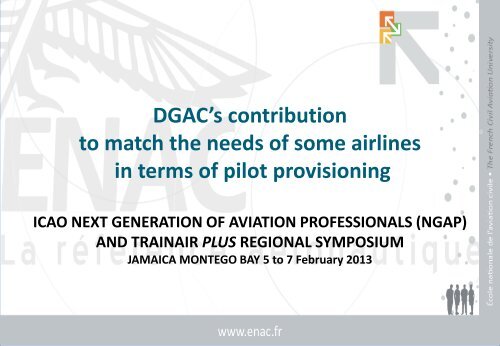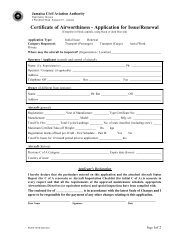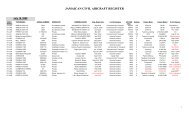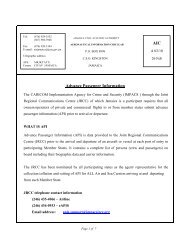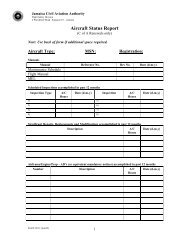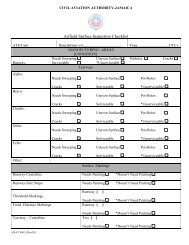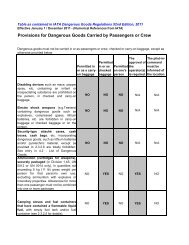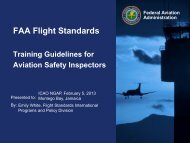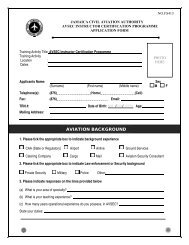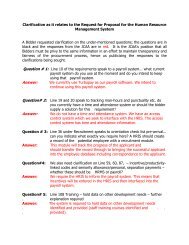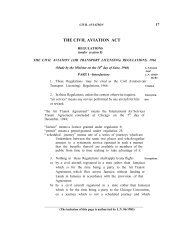Mr. Guy Martin (ENAC) - Jamaica Civil Aviation Authority
Mr. Guy Martin (ENAC) - Jamaica Civil Aviation Authority
Mr. Guy Martin (ENAC) - Jamaica Civil Aviation Authority
Create successful ePaper yourself
Turn your PDF publications into a flip-book with our unique Google optimized e-Paper software.
DGAC’s contribution<br />
to match the needs of some airlines<br />
in terms of pilot provisioning<br />
ICAO NEXT GENERATION OF AVIATION PROFESSIONALS (NGAP)<br />
AND TRAINAIR PLUS REGIONAL SYMPOSIUM<br />
JAMAICA MONTEGO BAY 5 to 7 February 2013
Summary<br />
• Pilot provisioning<br />
• DGAC’s contribution<br />
• Selection and training<br />
• DGAC’s objectives<br />
• Airlines’ benefits
Pilot provisioning<br />
• Major airlines usually recruit:<br />
– young professional pilots coming from private flight training<br />
schools,<br />
– experienced jet pilots from regional airlines or from general<br />
aviation companies,<br />
– and former military pilots.<br />
• But some of these airlines also hire:<br />
– State-sponsored young professional pilots.
DGAC’s contribution to the pilot provisioning<br />
• Every year, the DGAC (French <strong>Civil</strong> <strong>Aviation</strong> <strong>Authority</strong>)<br />
contributes to this pilot provisioning by conducting an EPL<br />
meritocratic competitive examination followed by an ATPL<br />
pilot training course sponsored by the French<br />
Government<br />
(EPL stands for and means Airline Transport Cadets).<br />
• Thanks to this contribution to match some of the airlines<br />
needs, the DGAC gives young people an opportunity to<br />
embrace the airline pilot career.
<strong>ENAC</strong> is the main actor<br />
• In fact, and for more than 50 years, the <strong>ENAC</strong> (French civil<br />
aviation university, part of DGAC) is in charge of :<br />
– Promoting this examination and this pilot training opportunity to<br />
young people (through <strong>ENAC</strong> website, forums, aviation events or<br />
fairs, conferences, visits to universities and information spread in<br />
preparatory schools and colleges),<br />
– Collecting and assessing the candidates’ applications,<br />
– Conducting the selection process,<br />
– And finally carrying out the Airline Transport Pilot training.
<strong>ENAC</strong>
<strong>ENAC</strong> in a few words<br />
• 4 areas of activities:<br />
– Initial training (2 000 trainees in 25 training programs)<br />
– Continuing training (7 500 trainees in 500 refresher courses)<br />
– Research and development<br />
– International (150 000 students from 100 countries on 5 continents)<br />
• A flight training school:<br />
– 50 years of flight training experience<br />
– 7 flight training bases<br />
– 120 ground and flight instructors<br />
– 17 fixed based simulators and 129 aeroplanes<br />
– Wide range of approved pilot and instructor courses<br />
– 1 000 pilot or flight instructor students trained per year
Selection criteria<br />
• Requirements to take the EPL/S selection process are:<br />
– To be an EC citizen,<br />
– To be 17 to 23 years old,<br />
– To have an higher scientific education level (at least 60 ECTS credits<br />
according to the European Credit Transfer and Accumulation System<br />
standard),<br />
– To be Class 1 medically fit.<br />
• There are three different types of EPL Cadets:<br />
– EPL/S as Scientific for young graduates with no previous flight experience;<br />
this course of study is the most important in terms of number of trained<br />
Cadets,<br />
– EPL/U as University for young people who have already passed all their<br />
ATPL theoretical certificates and<br />
– EPL/P as Professional for young people who already hold a commercial pilot<br />
license (CPL).
Selection process<br />
• Purpose of this selection : to seek strong motivation and<br />
potential skills to become a pilot.<br />
– Written tests,<br />
– Psychomotor and psycho technical tests,<br />
– Interviews,<br />
– Oral English language test,<br />
– Class 1 medical check.<br />
• As an example in 2012 : they were 1 812 EPL/S<br />
candidates. At the end of the selection process, only 28<br />
Cadets were selected.
Strong interest by young generation<br />
• The number of candidates is regularly increasing (1 400<br />
candidates ten years ago, which shows a strong interest<br />
of young people to access a pilot career through this<br />
training course).<br />
• The number of Cadets (EPL/S, U and P) varies from 40 to<br />
60 every year.
Airline Cadets training course<br />
• The Cadets attend an Integrated ATP training course<br />
compliant with the EASA requirements<br />
• They take and pass the following examinations:<br />
– ATPL theoretical certificates<br />
– CPL skill test<br />
– IR/ME skill test<br />
– MCC certificate completion<br />
• The training duration is 2 years<br />
• The training is free of charge<br />
• The Cadets pay for accommodation and food<br />
• This pilot training meets high standards and is well<br />
recognized and appreciated by major airlines
Cross-culture training<br />
(refer to article in ICAO TRAINING REPORT Number 2 2012, pages 10 to 12)<br />
• The <strong>ENAC</strong> is also in charge of the training of ATCO<br />
trainees in the same facilities, which allows to deliver<br />
common training modules for pilot and ATCO trainees<br />
either in classrooms, briefing rooms or simulators.<br />
• The <strong>ENAC</strong> is developing and implementing further joint<br />
training modules to acquire a better knowledge and<br />
understanding of the other’s job capabilities and<br />
constraints with the purpose of continuously upgrading<br />
flight safety and efficiency.
Joining an airline<br />
• Coming back to our Airline Cadets, as soon as their pilot<br />
training is completed at the <strong>ENAC</strong>, they apply for a<br />
copilot position in any airline they wish to join.<br />
• They undergo a selection process conducted by the<br />
airline which is not necessarily a French one. We have<br />
many examples of Cadets flying with European airlines<br />
(Lufthansa, easyJet, Ryanair, ..) or even flying with airlines<br />
outside of Europe such as Qatar Airways.<br />
• Then, they attend a type rating course and a line training<br />
course before acting as a standard copilot in this airline.
DGAC’s objectives 1/2<br />
• Allow a limited number of young people from social<br />
diversity to access this expensive state-sponsored training,<br />
through a competitive examination and pilot training.<br />
• Limited number of students means that there are other<br />
students who get an ATPL through private flight training<br />
schools.<br />
• Establish a well-recognised standard with stringent criteria<br />
in selection and high quality ATPL training phases.
DGAC’s objectives 2/2<br />
• Enhance the national flight safety by :<br />
– Providing the flight industry with the best students, recruited on the ground<br />
of their merits, with a cross-culture training (common training with ATCOs),<br />
– Developing new experimental training methods and tools in order to<br />
permanently upgrade the ATPL standard,<br />
– Sharing these methods with other flight training schools upon their<br />
request,<br />
– Designing new experimental pilot training programmes (MPL, etc),<br />
– Allowing other customers (foreign and French) to benefit from<br />
programmes’ breakthrough,<br />
– Assisting the French <strong>Civil</strong> <strong>Aviation</strong> <strong>Authority</strong> as an expert on matters related<br />
to flight training and safety.
Airlines’ benefits<br />
• Get high quality young professionals ready to act<br />
immediately as a standard copilot,<br />
• Implement with <strong>ENAC</strong> a feedback loop of the training<br />
results in order to adapt the syllabus if deemed<br />
necessary,<br />
• Get some of the best Cadets capable of evolving from<br />
pilots to high potential managers.
To conclude, this is the way the French DGAC contributes<br />
to the pilot provisioning to meet some of the needs of<br />
major airlines.<br />
Thank you very much for your attention !


